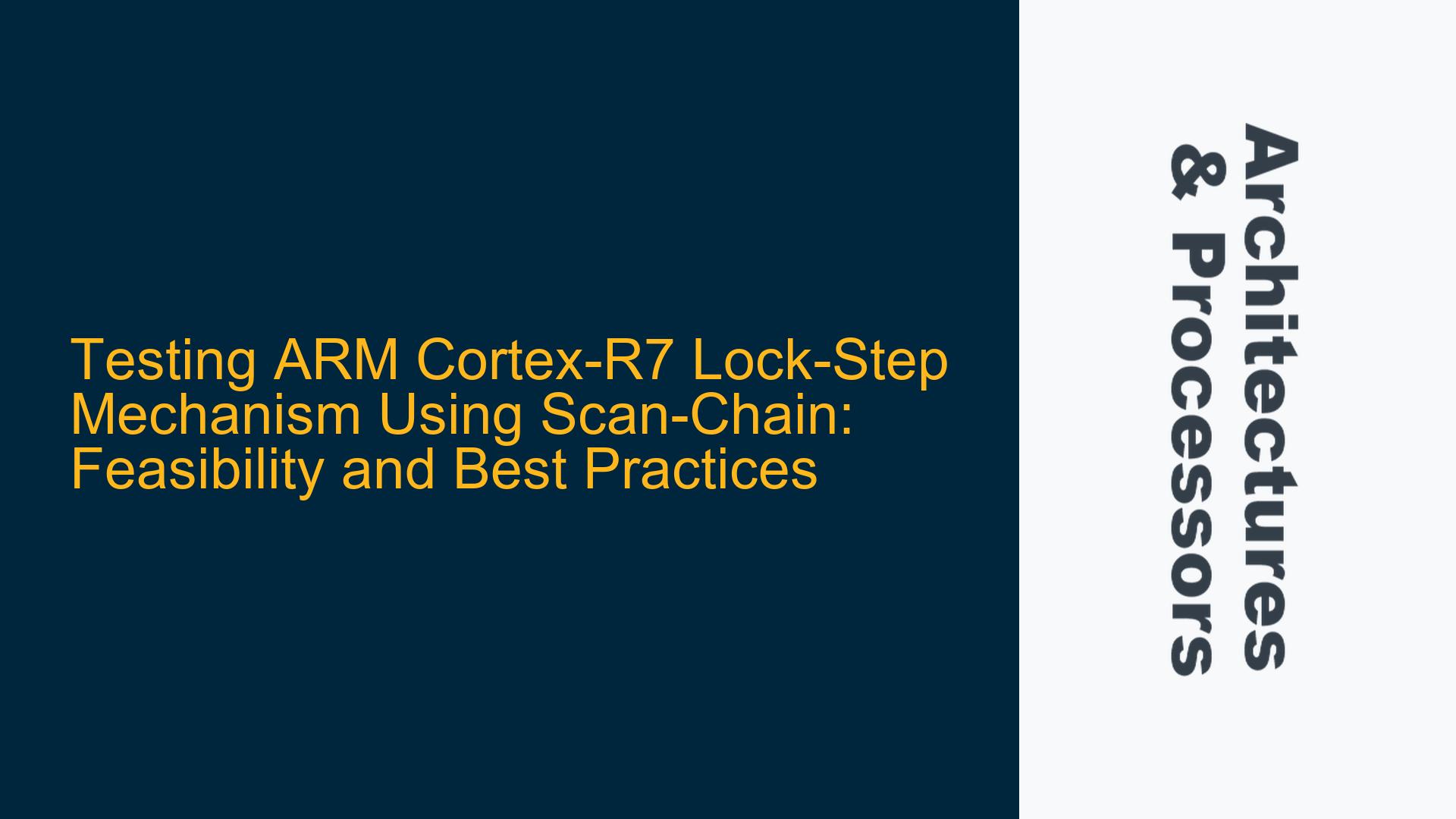ARM Cortex-R7 Lock-Step Mechanism and Scan-Chain Testing Feasibility
The ARM Cortex-R7 processor is widely used in safety-critical applications due to its dual-core lock-step mechanism, which ensures high reliability by running two identical cores in parallel and comparing their outputs. Any mismatch between the cores triggers a fault detection mechanism, making it a cornerstone of functional safety in automotive, industrial, and medical systems. However, testing the lock-step mechanism itself is a non-trivial task, especially when considering the use of scan-chain-based testing methodologies.
The lock-step mechanism relies on the redundant execution of instructions by two cores, with a comparator unit continuously monitoring their outputs. For this mechanism to be tested effectively, the system must simulate a fault condition and verify that the lock-step comparator detects the discrepancy. Traditionally, this involves stopping the clock to one of the redundant cores, forcing a mismatch, and observing whether the lock-step mechanism triggers a fault signal. This method requires precise control over the clock domains and a reset sequence to reinitialize the lock-step monitoring logic after the test.
The question arises whether a scan-chain-based approach can replace this traditional method. Scan chains are a common DFT (Design for Test) technique used to test digital circuits by serially shifting test patterns into the circuit and capturing the responses. While scan chains are effective for testing combinational and sequential logic, their applicability to the lock-step mechanism is less straightforward due to the dynamic nature of the lock-step process and the need to simulate real-time fault conditions.
Challenges in Using Scan-Chains for Lock-Step Mechanism Testing
The primary challenge in using scan chains to test the lock-step mechanism lies in the fundamental differences between static logic testing and dynamic fault simulation. Scan chains are designed to test the structural integrity of the logic gates and flip-flops by applying static test patterns and capturing the resulting states. However, the lock-step mechanism operates dynamically, relying on the continuous comparison of live outputs from two cores. This dynamic behavior cannot be fully replicated using static test patterns.
Another challenge is the need to simulate a fault condition in one of the redundant cores. In the traditional method, this is achieved by stopping the clock to one core, which creates a mismatch in the outputs. However, scan chains do not provide direct control over the clock domains or the ability to halt one core while the other continues running. Without this capability, it is difficult to create the necessary fault condition to test the lock-step comparator.
Additionally, the lock-step mechanism involves complex timing and synchronization requirements. The comparator unit must operate in lockstep with the cores, ensuring that the outputs are compared at the correct clock cycles. Scan chains, being inherently asynchronous to the functional clock, may not be able to replicate these precise timing conditions. This could lead to false positives or negatives in the test results, undermining the reliability of the lock-step mechanism.
Finally, the reset sequence required after testing the lock-step mechanism poses another challenge. The traditional method involves a system reset to reinitialize the lock-step monitoring logic. However, scan chains typically operate independently of the functional reset logic, making it difficult to integrate the reset sequence into the scan-chain-based test flow.
Implementing Effective Lock-Step Mechanism Testing with Scan-Chains
While the challenges are significant, it is not impossible to adapt scan-chain-based testing for the ARM Cortex-R7 lock-step mechanism. However, this requires careful design considerations and additional hardware support to address the limitations of traditional scan chains.
One approach is to enhance the scan-chain architecture to include control over the clock domains of the redundant cores. This could involve adding dedicated scan cells that allow the test logic to stop the clock to one core while the other continues running. By integrating these clock control cells into the scan chain, it becomes possible to simulate the fault condition required to test the lock-step comparator.
Another enhancement is the inclusion of timing synchronization mechanisms within the scan chain. This could involve adding delay elements or phase-locked loops (PLLs) to ensure that the scan-chain operations are synchronized with the functional clock. This would enable the scan chain to replicate the precise timing conditions required for the lock-step mechanism to operate correctly.
To address the reset sequence requirement, the scan-chain architecture could be extended to include a reset control cell. This cell would allow the test logic to trigger a system reset after the lock-step test is completed, ensuring that the lock-step monitoring logic is properly reinitialized. This would integrate the reset sequence into the scan-chain-based test flow, making it a seamless part of the overall testing process.
In addition to these hardware enhancements, the test patterns used in the scan chain must be carefully designed to replicate the dynamic behavior of the lock-step mechanism. This could involve creating test patterns that simulate the expected outputs of the redundant cores under normal and fault conditions. By comparing the captured responses with these expected patterns, the scan chain can verify the correct operation of the lock-step comparator.
Finally, it is essential to validate the scan-chain-based testing approach through extensive simulation and emulation. This would involve creating a detailed model of the ARM Cortex-R7 processor, including the lock-step mechanism and the enhanced scan-chain architecture. By running simulations with various test patterns and fault conditions, it is possible to verify the effectiveness of the scan-chain-based testing approach and identify any potential issues.
In conclusion, while traditional scan-chain-based testing methods are not directly applicable to the ARM Cortex-R7 lock-step mechanism, it is possible to adapt them with careful design considerations and additional hardware support. By enhancing the scan-chain architecture to include clock control, timing synchronization, and reset sequence capabilities, and by designing appropriate test patterns, it is possible to create an effective testing methodology for the lock-step mechanism. However, this approach requires significant effort and validation to ensure its reliability and effectiveness in safety-critical applications.






